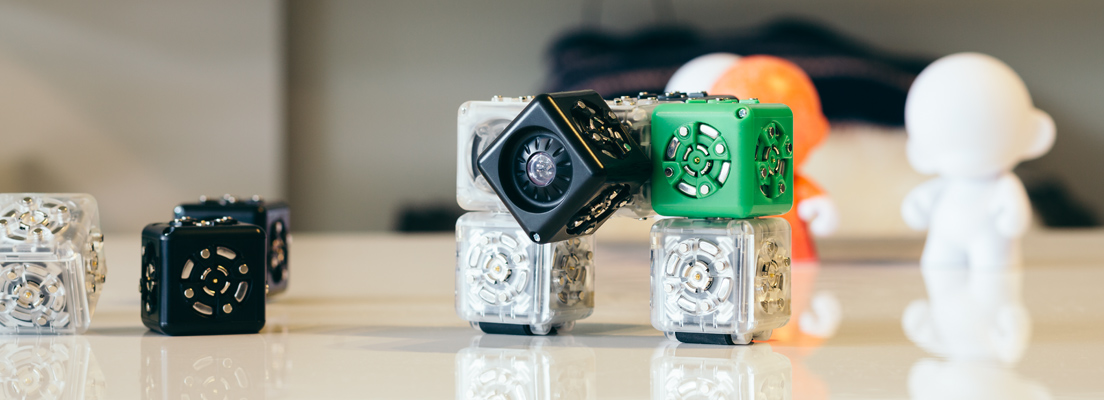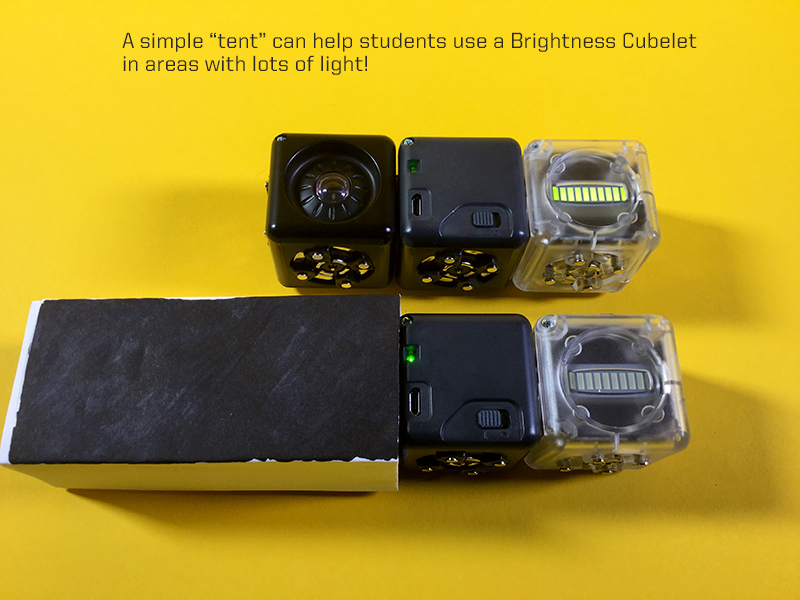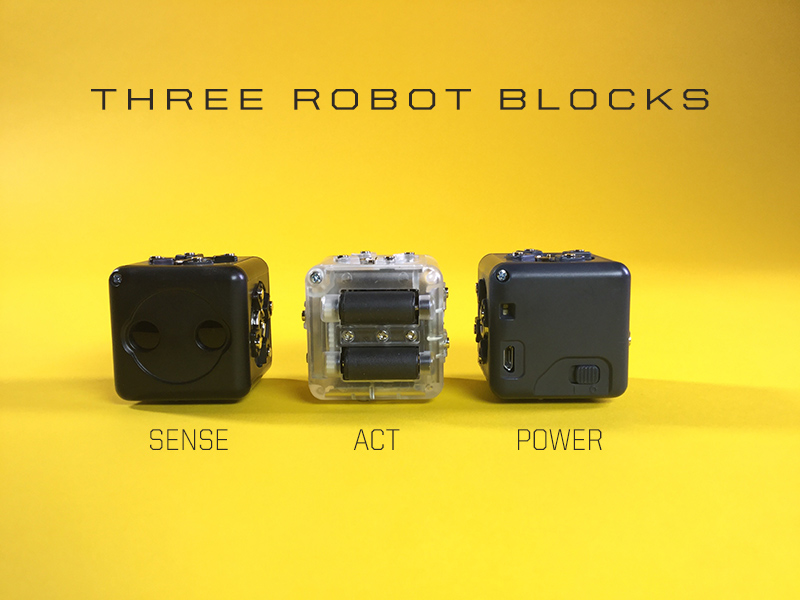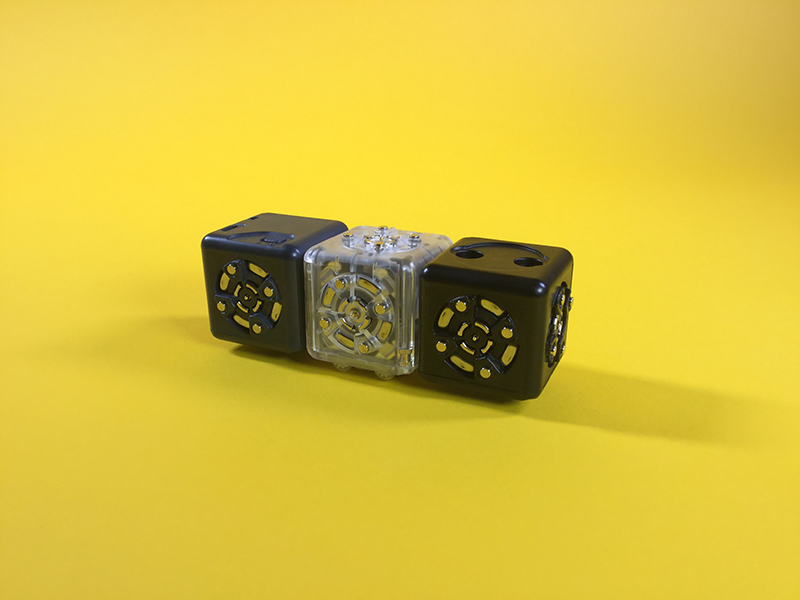A.A.1 | Introduction and Exploration of Robots

Created by: Modular Robotics
Lesson Overview:
This is a hands-on lesson introducing students to the exciting world of Cubelets. This is an exploratory lesson allowing students to discover on their own, with the teacher facilitating, how to use Cubelets to build robots that sense and act. They will use their observations to make a theory, test it, and refine it using different inputs. Students will also be building their scientific skills and laying the groundwork for taking careful note of their observations in order to analyze and synthesize the data they collect. This lesson is also a building block in their understanding of emergent behavior.
Be sure to read the Educator Information Sheet for essential information in understanding how to interpret all the Cubelet lesson plans. We highly suggest you keep this document handy. As you–and your students–learn more and more about Cubelets, you will find it to be a handy reference tool.
The Basics:
Ages: 13 – 17 years (grades 7 – 12)
Time: 45 – 60 minutes
Prep Time: 5 minutes
Lesson Goal (for the educator): To build robots using Cubelets and begin to understand sense and act concepts, and how input/stimuli effects output/behavior.
Lesson Objectives (for the students): I will explore with Cubelets to understand how cubes work together to create robots. I will build robots and discover how input/stimuli has an effect on output/behavior.
Essential Questions: How many different ways can we build robots? What is the relationship between input/stimuli and output/behavior?
21st Century Skills: Creativity and Innovation, Critical Thinking and Problem Solving, Communication and Collaboration
Concepts: Scientific method, relationship between input/stimuli and output/behavior, emergent behavior, data collecting
Vocabulary: Stimuli/input, reaction/output, behavior, emergent behavior
Required Cubelets: Seven Cubelets: Distance, 2 Drive, Battery, Brightness, Rotate, Flashlight – enough for each group of 2-5 students. (Sense and Action Cubelets only plus the Battery.)
Additional Materials: Student Robotics Journals, flashlights and tents (referenced in the Educator Information Sheet)
The Standards:
ISTE: International Society for Technology Education
Creativity and Innovation 1.b, 1.a, 1.c, 1.d Communication and Collaboration 2.d Research and Information Fluency 3.a, 3.d Critical Thinking, Problem Solving, and Decision Making 4.a, 4.b, 4.c, 4.d Technology Operations and Concepts 6.a, 6.b, 6.c, 6.d
CCSS: Common Core Standards
ELA-Literacy.W.7.10, W.8.10, W.9-10.10, W.11-12.10
NGSS: Next Generation Science Standards
MS-ETS1-4
Prior Knowledge Necessary for the Student:
Understanding and experience using the scientific method: making hypotheses, predicting, testing, collecting data, analyzing, synthesizing, evaluating and drawing conclusions. Collaborating as a team, note-taking and lab report writing.
- If no prior knowledge: Lesson of your own
Prior Knowledge for the Educator:
- Watch the video Getting Started with Cubelets (below). You may want to consult the Educator Information Sheet too!
- Watch the 7 Bots video from Modular Robotics (below).
- Familiarize yourself with the Cubelets – take note of the various sensing and thinking cubes and the many configurations you can use to build robots that perform different actions. Make some of your own robots to gain an understanding of how they operate.
- A robot is a machine that can sense, think and act on its own. Robotics is the science of designing, building, controlling and operating robots.
- Steps of the scientific method: – ask a question – do background research – construct a hypothesis – test your hypothesis by doing an experiment – analyze your data and draw a conclusion – communicate your results.
- In order for students to form theories about the sense component of their robot they must investigate presenting varying input/stimuli to the Sense Cubelet. In this lesson, students will practice observing behavior and build understanding of stimuli/input and the correlation to reaction/output.
- Emergent behavior is the behavior of a system that does not depend on its individual parts, but rather on their relationships to one another. It is essential in systems thinking to have an understanding of the parts and their relationships – an understanding of the structure of a system as a whole. Without the understanding of the structure of a complex system, the only way to solve an emergent behavior problem would be through trial and error. For complex problems this would prove to be impossible.
- In philosophy, systems theory, science, and art, emergence is a process whereby larger entities, patterns, and regularities arise through interactions among smaller or simpler entities that themselves do not exhibit such properties.
Educator Tips:
- Be sure all students work together and get to experiment with the Cubelets.
- Be sure that all the Battery Cubelets are charged.
- Have flashlights and tents available.
- Students may rush to try out many different configurations with the Cubelets and become confused about what senses cause which behaviors.
- As you ask the students questions, encourage them to formulate hypotheses.
 “
“
Preparation:
- Divide the class into groups of 2-5 students.
- For each group, place in a container the necessary Cubelets.
Lesson:
Introduction:
-
Time: 2-3 Minutes
- “Today you will be able to explore with our new Cubelets with your lab partners/group. Your objective will be to use the Cubelets and figure out how the cubes work together as you build robots that sense and act. You will need to work cooperatively with your group and make sure that each person is involved in the work.”
- “First, let’s review what we mean by sense and act.” Take a minute to call upon students to review these terms with the class. Show them the Cubelets explaining which ones sense (the black ones) and which ones act (the clear ones). Show them the on/off switch on the Battery (the grey one) and let them know that all cubes will need to have power from the Battery to work. Explain that they will know if the Battery is giving power to the other cubes because each cube will have a blinking green light when they are being powered by the Battery.
- Review the Objective and introduce/review the vocabulary, except for emergent behavior.
- “Let’s see how many different robots you can build by rearranging the Cubelets into different configurations.”

Time to Explore
-
Time: 10-15 Minutes
- “First, we will make a robot with as few cubes as possible. Your team should only use three cubes. The Distance Sense cube, the Drive Act cube and every robot needs a power source and yours will be supplied by the Battery Cubelet – remember, it is grey and has a switch to turn on and off the power.”
- Allow the students to explore and work together making their team robots. Optional: Have your students use the worksheet (A.1.WS) to help them keep track of the robots they build.
- To facilitate this, walk around the room asking questions such as the following:
- What do you think is causing your robot to move?
- What could your robot be sensing?
- How can you test for this? Encourage them to try something like clapping, speaking to it, etc.
- Help them notice that whenever they come close to the black Sense Cubelet the robot moves
- What makes your robot stop moving?
- Your robot is moving forward, can you get it to move backward?
- Can you get your robot to move in a circle?
- How many different configurations can you make, and how does each effect the action of your robot?
- Can you build your robot to be taller than one cube high?
- Are there other ways to get your robot to move besides using your hand?
- If you could use this robot for a task, what might you get this robot to do?
- If you could add another act cube to this robot what might that act cube be, and what might your robot be able to do?
- Stop the class and ask some of the groups to share what they have discovered.
- “Now, your team can use the other Sense and Act cubes to build more robots. See what you can discover now.” Allow students to explore building robots with all these Cubelets.
- To facilitate this, walk around the room asking questions such as the following:
- What happens when you use more than one sense Cubelet?
- What happens when you use more than one action Cubelet?
- How can you be sure which sense your robot is using?
- How many different configurations can you make, and how does each effect the action of your robot?
- How can you make your robot move faster or slower?
- If you could use this robot for a task, what might you get this robot to do?
- Stop the class and ask some of the groups to share what they have discovered. See if anyone has surmised that the Battery is acting as a thinking cube in the robots.
- Allow the students more time to explore with their new knowledge.

Time: 10-15 Minutes
Time: 2 Minutes
Time: 5-10 Minutes
Closure/Evaluation:
-
Time: 5 Minutes
- Recap with students what they learned in this lesson. Review and discuss some of the relationships between Cubelets that they noticed. Discuss emergent behavior.
- Stop the class again and give them time to record their observations and conclusions in their Robotics Journal or lab notebook. Encourage them to use words and other methods of recording such as charts, sketches, flow charts, mind maps, etc. (Refer to the Educator Information Sheet)
- Allow time for students to put materials away and plug in the battery Cubelets for recharging.
Time: 5 Minutes
For more information on mind mapping:
Time: 1 Minute
End Results:
Students will work together building robots using a variety of Sense and Action Cubelets to draw conclusions about input/stimuli and output/behavior. They will explore behaviors and recognize emergent behavior.
Optional Quick Write For Prompt and/or Evaluation:
Have students fill out the My First Experience with Cubelets evaluation sheet (Appendix A.M.1).
What To Go To Next:
For More Review:- Repeat this lesson, Introduction and Exploration of Robots A.A.1
Note: At times, you will notice that the lessons may be the same for the students at different levels, this is because many lessons are essential to all students – especially in the beginning as they learn the basic concepts involved in using Cubelets.
This work is licensed under a Creative Commons Attribution-ShareAlike 4.0 International License.


